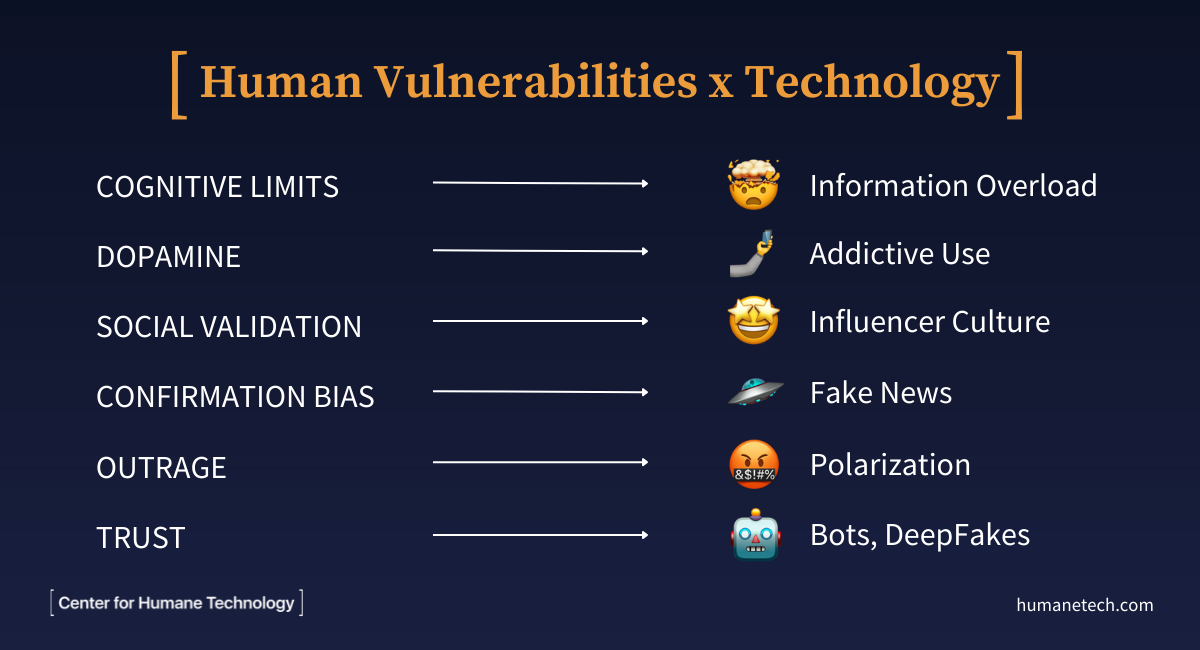The scope and speed of our world’s issues — from climate-induced migration to global financial fragility — are accelerating and growing more complex. And yet, our ability to comprehend those challenges and respond accordingly, across all sectors, is not matching pace.The gap between the rising interconnected complexity of our problems and our ability to make sense of it all is "The Wisdom Gap." And while technology isn’t the sole cause, runaway technology is rapidly widening that gap even further.

1. TECHNOLOGY INCREASES THE COMPLEXITY OF ISSUES
We live in a world of interconnected issues. Yet, technological advancement — even when created with positive intentions — can supercharge existing problems and power dynamics. For example,
- Advances in AI have made disinformation campaigns easier to operate and more successful.
- Synthetic media (e.g., DALL·E 2) can exacerbate war and conflict because almost anyone can produce believable fakes. We’ve seen this in Myanmar, Ethiopia, and Ukraine.
- Widely available 3D printing has enabled the rise of 3D-printed firearms.
As a result, we're seeing issue complexity accelerate and become more interlocking, which makes problem-solving harder.
2. TECHNOLOGY DECREASES OUR SENSE-MAKING ABILITIES
In addition to driving up complexity, runaway technology also decreases our ability to make sense of the increasingly complex issues.Much of today’s most powerful technology fails to respect our human psychology and paleolithic hardwiring. This had led to disastrous results, which we've collectively seen play out over the last 15+ years.
Technology that takes advantage of human vulnerabilities — like cognitive limits, how our dopamine systems work, or our need for social validation — negatively affects us and those around us.

TECHNOLOGY AS AN AMPLIFIER
Amplification theory states that technology is not neutral and that technology's impact depends on the context in which it is placed (read more here and here). Technology will amplify the forces at play within a given context, such as bias and human vulnerabilities.
For example, in a society experiencing civil conflict technology can add fuel to the fire by making it far easier for bad actors to spread disinformation and target victims. The ultimate impact will vary based on the context, but technology will interact with existing contexts and amplify them.
CLOSING THE WISDOM GAP
Our world’s biggest problems are coordination problems that require collective action. Creating the conditions to tackle them means replacing our old, extractive technology paradigms with new humane ones.
Operating from more humane paradigms leads to more humane technology. And more humane technology helps close "The Wisdom Gap." That's because humane technology counteracts both forces. It reduces the complexity of our issues and increases our capacity to respond.
More than ever, we need wisdom to wield our god-like technology.

This piece has been adapted from a recent talk that Tristan Harris gave at Wisdom 2.0. You can watch his full talk and presentation here.
WHAT WE'RE READING, LISTENING TO, AND WATCHING
On Social Media and Society
- In “Why the Past 10 Years of American Life Have Been Uniquely Stupid,” Jonathan Haidt compares American society today to the Biblical story of Babel. He argues that social media breaks down society and democracy by depleting social capital, weakening institutions, and minimizing shared stories.
- In a recent Anchor Change newsletter, Katie Harbath shares her thoughts after reading Haidt’s piece (above), including what resonated, what didn’t, and what she sees as necessary to democracy.
On Platform Transparency
- Integrity Institute released a report on Facebook’s Widely Viewed Content for 2021 Q4. One of the biggest takeaway: only ~20% of the top content on Facebook passes all of Integrity Institute’s media literacy checks.
- Renée DiResta, Laura Edelson, Brendan Nyhan, and Ethan Zuckerman outline the benefits, and the specific questions that we could answer, if social media companies granted independent researchers access to their data.
- Dr. Brandie Nonnecke and CHT’s Camille Carlton discuss two legislative efforts to open up platform data — the EU Digital Services Act and the US Platform Accountability & Transparency Act — and provide recommendations to strengthen their impact.
On Twitter and Musk
- Last week, we released a bonus Your Undivided Attention exploring the opportunities and risks of a privately-held Twitter.
- Similarly, Jack Dorsey showed excitement and relief that Twitter could be moving away from a quarterly earning cycle while Anjana Susarla, responsible AI professor, highlighted the issues that a Musk-owned Twitter could bring.
- Shoshana Zuboff urged people to consider that the existing debate – focused on the impacts of one person's actions – reflects how fragile our critical information infrastructure is without the “democratic rule of law.”
- Finally, James Stewart outlines what considerations were made when the deal was agreed upon (spoiler: it was mostly financial).


